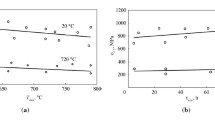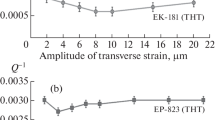Abstract
The level of the magnetoelastic properties and their stability in a wide range of temperature and strain effects are determined by the combination of various bysteretic and relaxational mechanisms of energy dissipation in the material. The design of corrosion-resistant steels based on the system Fe-Cr with high stability and good damping ability is a complex practical problem. The aim of the present work is to investigate the relations of magnetic and dislocational hysteretic mechanisms of energy dissipation of vibrations in the hertz frequency range and in a broad temperature range, and also to investigate the conditions of attaining a stable highly damping state of high chromium ferritic steels.
Similar content being viewed by others
References
I. S. Golovin and I. Yu. Kanunnikova, “Effect of preliminary deformation on the damping ability of ferritic high chromium steel type Kh16,” Metalloved. Term. Obrab. Met., No. 7, 35–38 (1993).
I. S. Golovin and N. Ya. Rokhmanov, “The mechanism of formation of the damping state of high chromium ferritic steels,” Metalloved. Term. Obrab. Met., No. 9, 29–34 (1993).
I. B. Kekalo, “Magnetoelastic phenomena,” in: Metal Science and Heat Treatment of Metals: Achievements of Science and Technology, Vol. 7, VINITI, Moscow (1973), pp. 5–88.
I. A. Varvus and B. G. Strongin, “Modernized method of measuring low-frequency internal friction in highly damping materials,” in: Damping Metallic Materials: Abstracts of Paper of the 5th Scientific and Technical Conference, Kirov (1988), pp. 96–97.
S. A. Golovin, A. Pushkar, and D. M. Levin, Elastic and Damping Properties of Structural Metallic Materials [in Russian], Metallurgiya, Moscow (1987).
I. S. Golovin, V. I. Sarrak, and S. O. Suvorova, “Influence of carbon and nitrogen on ‘475°C embrittlement’ of highchromium ferritic steels,” Met. Trans.,23A, No. 9, 2567–2579 (1992).
M. S. Blanter and Yu. V. Piguzov (eds.), Application of the Methods of Internal Friction in Metal Science Research [in Russian], Metallurgiya, Moscow (1991).
Additional information
Moscow State University of Aviation Technology. Chernovitsky State University. Translated from Metallovedenie i Termicheskaya Obrabotka Metallov, No. 1, pp. 26–30, January, 1994.
Rights and permissions
About this article
Cite this article
Golovin, I.S., Varvus, I.A. Influence of the temperature on the damping ability of high chromium ferritic steel. Met Sci Heat Treat 36, 41–47 (1994). https://doi.org/10.1007/BF01408602
Issue Date:
DOI: https://doi.org/10.1007/BF01408602




